Land Invertebrates
Media
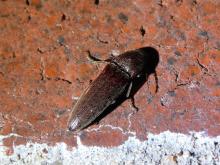
Species Types
Scientific Name
Approximately 1,000 species in North America
Description
Their streamlined shape is distinctive, but the behavior of click beetles is even more unique: Placed on their backs, these beetles flip suddenly into the air with an audible click.
Media

Species Types
Scientific Name
Nearly 500 species in North America north of Mexico
Description
Soldier beetles are most often seen on flowers. Many species in this family are pollinators. Yellow, orange, and red are their most common colors, besides black and brown.
Media
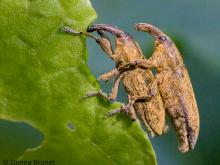
Species Types
Scientific Name
Lixus concavus
Description
The rhubarb weevil has a dusty, bright yellow coating and feeds on rhubarb, dock, thistles, and other plants in the smartweed or buckwheat and sunflower families.
Media
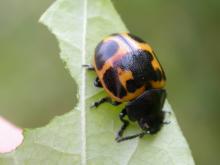
Species Types
Scientific Name
Labidomera clivicollis
Description
The swamp milkweed leaf beetle is found on the various milkweeds it eats, often in grassy areas or on roadsides. The exact pattern of orange and black varies among individuals.
Media

Species Types
Scientific Name
Neoharmonia venusta
Description
The V-marked lady beetle, one of our many native lady beetles, is very attractive. The pattern and coloration can vary greatly among individuals, but most in this species have a V on the back.
Media
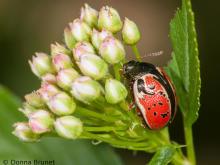
Species Types
Scientific Name
Calligrapha spiraea
Description
The ninebark calligraphy beetle is one of nearly 40 North American calligraphy beetles, named for the scrawly markings on their backs. Most calligraphy beetles require particular host plants.
Media

Species Types
Scientific Name
Acanthoderes quadrigibba
Description
The four-humped flat-faced longhorn has no true common name, but its markings are distinctive. It plays an important role in breaking down rotten wood and enriching soils.
Media
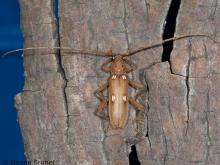
Species Types
Scientific Name
Eburia quadrigeminata
Description
The ivory-marked beetle is a longhorned beetle whose larvae bore deep into the heartwood of a variety of deciduous trees, including oak, hickory, maple, cherry, ash, elm, and more. It can live for 40 years.
Media
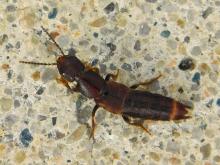
Species Types
Scientific Name
More than 4,400 species in North America north of Mexico
Description
Rove beetles usually have very short wing covers, so several of their hind abdominal segments are exposed. Typically fast movers, they often flip up their abdomen tips when frightened. This is a huge family of beetles.
Media
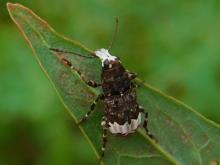
Species Types
Scientific Name
About 120 species in North America north of Mexico
Description
Fungus weevils are a family of beetles that differ from other weevils by their broad, flat bills and clubbed, but not elbowed, antennae. It's a diverse group, but many do feed on bracket mushrooms and other fungi.
See Also



Media

Species Types
Scientific Name
Cisseps fulvicollis
Description
The yellow-collared scape moth is more often “orange-collared.” And whether you think it looks more like a firefly or a wasp, it’s still a moth!
Media

Species Types
Scientific Name
Nearly 150 species in North America north of Mexico
Description
Slim, delicate plume moths are instantly recognizable by their T-shaped silhouette, long legs, and muted shades of tan and brown. It can be hard to separate the various species.
Media

Species Types
Scientific Name
Pyrrharctia isabella
Description
Not many people know the adult Isabella tiger moth when they see one, but we’re all acquainted with its caterpillar, the woolly worm, or woolly bear.
About Land Invertebrates in Missouri
Invertebrates are animals without backbones, including earthworms, slugs, snails, and arthropods. Arthropods—invertebrates with “jointed legs” — are a group of invertebrates that includes crayfish, shrimp, millipedes, centipedes, mites, spiders, and insects. There may be as many as 10 million species of insects alive on earth today, and they probably constitute more than 90 percent all animal species.





















